"Motolyga" against "Malva", "Booker" and "Three Axes"
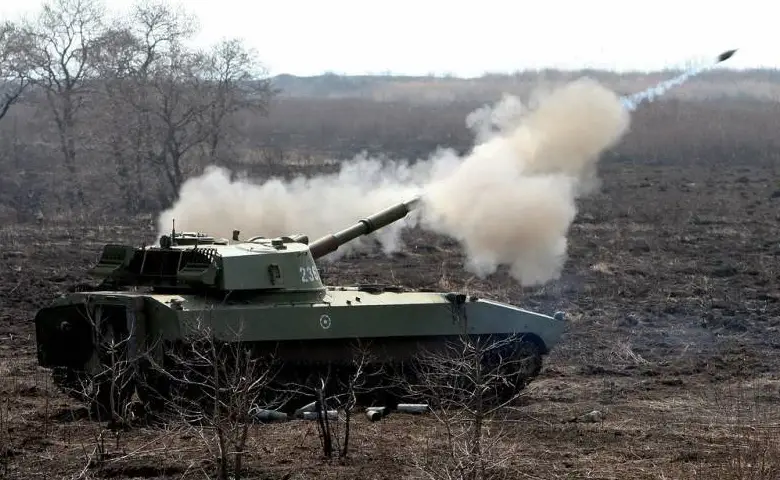
At the turn of the two years of the special military operation in Ukraine, a strong public opinion developed that the current state of the artillery fleet of the Russian Armed Forces does not fully meet the requirements of the battlefield and the realities of counter-battery warfare with Western-made models. The complaints are formulated in two phrases: insufficient firing range and low accuracy.
And now, to dive into the topic and background of the issue, let’s look at a few quotes as food for thought.
The Main Artillery Directorate of the Russian Empire considered a caliber of 48 lines to be the minimum sufficient for this purpose and ordered the first samples of howitzers of this caliber from the companies Krupp and Schneider. During the First World War, 122 mm howitzers were highly praised by the Russian military. In interwar and wartime, the USSR created long-range field and powerful tank guns of this caliber.
At the end of the 1970s. The production of 122 mm caliber guns in the USSR was stopped - tank guns switched to 125 mm caliber, and towed and self-propelled artillery to 120 mm in order to be able to fire mortar ammunition of this caliber.”
Nevertheless, Wikipedia claims that as of 2017, the Russian Ground Forces had 150 units of 122-mm 2S1 Gvozdika self-propelled guns (another 2 units in storage!), 000 units in the Coastal Forces of the Navy, and 95 units in the Pogranichnaya the FSB service has another 90. This is a total of 18 divisions of 18 guns.
But nevertheless, the howitzer continued to be used at the 7th military base in Abkhazia, and a howitzer division was included in the newly created 2016th motorized rifle brigade in 30. Also used by the 22nd Army Corps of the Coastal Forces of the Navy in Crimea.”
As of 2016, the Russian Ground Forces had 800 units of 152-mm 2S3 Akatsiya self-propelled guns in service (another 1 units were in storage) and 000 units in the Coastal Forces of the Navy.
The minister’s decision in 2013 to replace 122-mm towed guns with 152-mm systems is certainly correct and has made an undoubted contribution to increasing both the power of ground forces artillery and its mobility on the battlefield. But in the same 2013, it was impossible not to know that in Germany, since 1998, the production of 155-mm self-propelled guns PzH-2000 with a barrel length of 52 calibers has been launched (versus 28 guns for the Acacia self-propelled guns and 47 guns for the Msta-B). , and in the United States, since 2005, production of the lightweight 155-mm towed howitzer M777 with a barrel length of 39 klb began, which will surpass the domestic self-propelled guns “Gvozdika” and “Akatsia” in terms of firing range.
About the Akatsiya self-propelled gun in other words: in 2013, the re-equipment of artillery units began on the model adopted for service in 1970 and the production of which was discontinued in 1993, i.e. 20 years ago. Of course, such a decision was influenced by both political and economic circumstances, and, probably, it was not easy. Now it's already story, and at the moment we have what we have.
The reality is that back in the mighty USSR it was decided to bury 122 mm artillery (more precisely 121,92 mm - 4,8 inches or 48 lines). It is very difficult and time-consuming for us to gradually move away from the system of inches and their derivatives. On the other hand, a number of foreign and domestic experts note as an advantage the still existing presence of two calibers of Russian artillery, 122 mm and 152 mm.
In the West, traditionally more emphasis is placed on the use aviation on the battlefield as opposed to the artillery systems of the ground forces. And the failure of the Ukrainian counter-offensive according to American patterns without air supremacy and in the absence of air support, despite some advantages in the characteristics of artillery systems, is proof of this.
On our part, based on the experience of the present, albeit extensive, but still local conflict, it is probably necessary to reconsider a number of decisions on the ways of developing field artillery.
All of the following domestic developments in the 120-mm caliber are inferior in firing range to the Gvozdika and Akatsiya self-propelled guns from the 70s of the last century, which are gradually being withdrawn from service. Moreover, it is incorrect to compare the accuracy of firing 120-mm mines from a remake with the accuracy of firing full-fledged shells from old women’s rifled guns.
“Nona 2S9” – 120-mm rifled semi-automatic gun-howitzer-mortar; 12,8 km.
“Vena 2S31” – 120-mm rifled semi-automatic gun-howitzer-mortar; 14 km.
“Khosta 2S34” – 120-mm rifled semi-automatic gun-howitzer-mortar; 14 km.
“Lotos 2S42” – 120-mm rifled semi-automatic gun-howitzer-mortar; 13 km.
“Pat-S 2S18” – 152 mm rifled howitzer; 15,2 km.
“Malva 2S43” – 152 mm rifled howitzer; 24,5 km.
The last two samples from the list in 152 mm caliber, in terms of their totality of characteristics, are not only not able to compete on equal terms with the best foreign samples, but are also inferior to the few last Soviet artillery systems of a similar caliber, “Gyacinth”, which have been unworthily put into storage.
Having studied the contents of Table No. 1, we objectively come to the conclusion that domestic artillery, with approximately equal caliber and weight of artillery ammunition, is significantly inferior to foreign models in the length of gun barrels, as well as in the volume of propellant charges used, which naturally entails a loss in firing range.
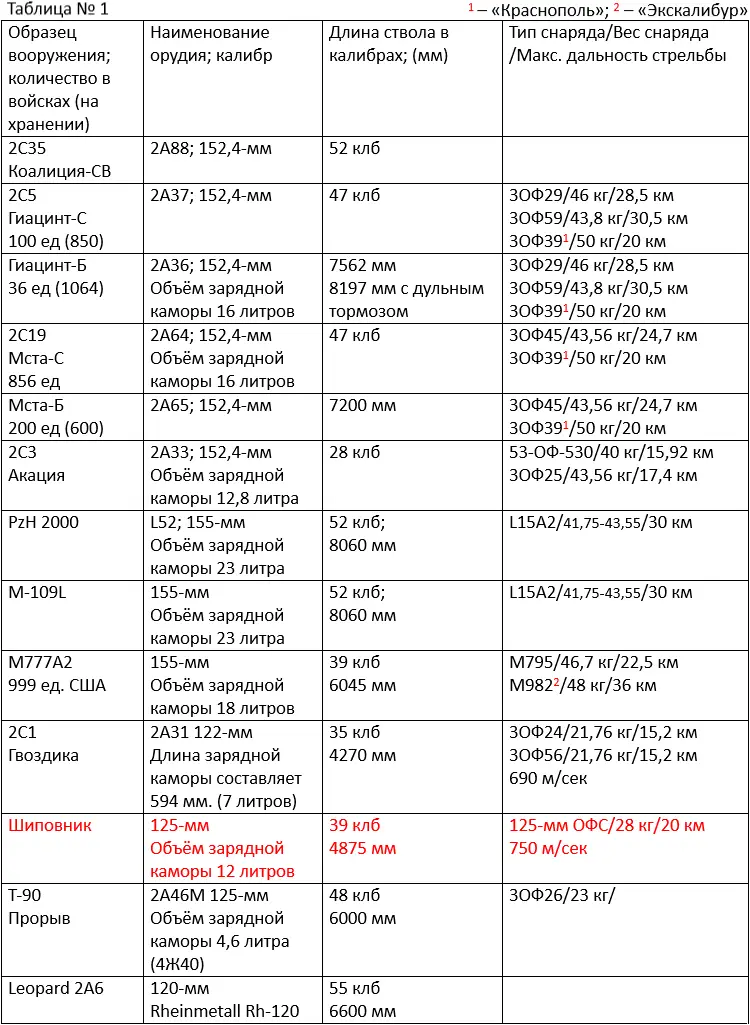
The logical consequence of such concessions or miscalculations, or perhaps strategic errors in development planning, is the current loss in firing range on the battlefield and the difficulty of conducting counter-battery warfare.
All of the above does not pretend to be even a superficial analysis of the situation, and certainly not a criticism. But the severity and urgency of the problem requires its comprehensive discussion, then the author will try to express and defend his point of view.
The niche of towed and self-propelled 122-mm guns and even the short-barreled 152-mm self-propelled gun “Acacia” should be occupied by a new self-propelled rifled gun of 125-mm caliber (in the article we call it “Rosehip”, according to the established “flower” tradition). On the Borodino field, Kutuzov had about 640 field artillery guns; in the final stages of the Great Patriotic War, in areas where enemy defenses were broken through, there was a concentration of up to 300 artillery barrels, mortars and MLRS per kilometer.
Nowadays, similar tasks can be carried out with the help of nuclear weapons by aviation, and by OTRK, and by the same artillery. But we can’t supply each stronghold of a platoon or company with a 152-mm self-propelled gun, so we have to work from closed positions with tanks that are not at all suited for such tasks. Here is a popular and visual drawing, pay attention to the angles of 20 and 70 degrees.
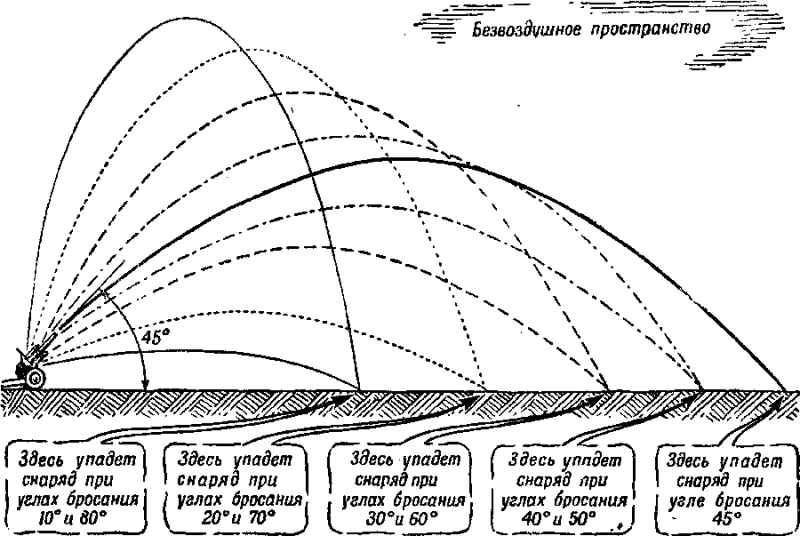
The vertical pointing angle of the T-90 tank’s gun is exactly the same 20 degrees (for the 2S25 Sprut-SD product this parameter is even less - 15 degrees). The situation is similar with the newly created American couple “Abrams” and “Booker”.
On the battlefields of Ukraine, neither the Abrams, nor the Challengers, nor the Leopards showed any outstanding results as a means of fire support, and it seemed that there was no other place to demonstrate this in a counter-offensive. They simply do not have time to reach the front edge in order to fire a direct fire shot, and the light towed 155-mm howitzer M777A1 is well adapted for firing from closed positions. In addition, the accuracy of flat trajectory fire from smooth-bore tank guns from closed positions, even theoretically, cannot be compared with the accuracy of howitzer fire.
This was well understood even in the Wehrmacht before World War II. Experts also note the unreasonably low filling coefficient of the 3OF26 tank high-explosive fragmentation projectile (the ratio of the mass of the explosive charge to the mass of the projectile); in this regard, the T-90 is inferior even to the outdated 122-mm rifled howitzers, which are gradually being removed from service.
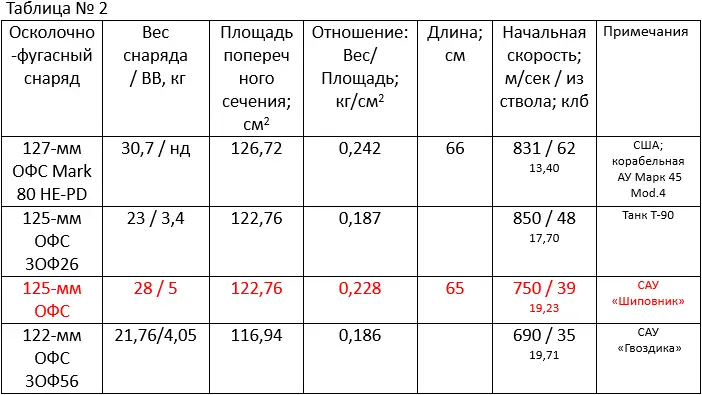
So it turns out that the main advantage of a tank as an artillery platform lies only in the heavy armor protection of the vehicle and relatively high mobility (if by this we mean the ratio of engine power to weight), which allows it, with an acceptable degree of risk, to drive closer to the line of combat contact than the clumsy heavy and lightly armored self-propelled guns.
Thus, if we develop and create from scratch a 125-mm rifled gun and a heavy projectile with the characteristics from the red lines of Tables 1 and 2, then we will get a full-fledged replacement for the entire fleet of towed 122-mm howitzers and self-propelled guns “Gvozdika” and “Akatsiya”.
"Motolyga" - multi-purpose light tracked transporter MTLG
As you already guessed what we will talk about, but you were wrong. This will not be another reincarnation of the good old Kharkov MT-LB, but, I hope, a modern development of Muromteplovoz OJSC. Just as a genetically modified organism is superior in quality to its ancestor from the wild, so MTLG will only have an external resemblance to its predecessor from the 60s of the last century.
Development goals. The transporter must be ready to haul the entire fleet of towed guns of the Russian Army across the battlefield; become a worthy replacement for the entire list of weapons and military equipment based on MT-LB; and as a program, at most, become a single platform for the formation of light units and motorized infantry units similar to the American Stryker armored fighting vehicle.
Everything is relative. In this section, to compare certain values of the characteristics of the new machine, data on the classic MT-LB will be reflected in parentheses; mention of other samples will be specified. The name of the new conveyor retains the adjectives multi-purpose and lightweight.
We must pay tribute to its predecessor; over time, and in terms of its range of applications, the MT-LB became a universal rather than a multi-purpose vehicle. But with the advent of towed howitzers “Msta-B” and then “Gyacinth-B” with a mass of 7 tons and 9,7 tons, it became impossible for a really light transporter to carry them off-road. Multi-axle heavy wheeled tractors became standard towing vehicles.
The main idea behind the development of a new light tractor is to increase its load capacity, increase the volume of the cargo compartment with sufficient strength and rigidity of the hull for mounting a wide range of weapons and military equipment. And although it will not become a regular tractor for the mentioned howitzers, it should become a kind of lifesaver off-road for equipment up to 10 tons. With a curb weight of the MTLG of 12 tons (9,7 tons) and a payload of 3 tons (1,5 tons), the combat weight of the vehicle will be 15 tons (12,2 tons).
Agree, this will still be a light weight category. A twofold increase in payload and a twenty percent increase in combat weight of the new vehicle naturally requires a new engine. The long-awaited replacement for the previous V-shaped eight-cylinder naturally aspirated diesel engine with a power of 240 hp. With. becomes an in-line six-cylinder turbocharged engine YaMZ-770 with a power of 360 hp. With.
This is exactly that rare case when there cannot be two opinions; technical progress has not looked into the engine compartment of a domestic bestseller for too long. The new engine produces a third more power while reducing the occupied volume and weight by about 10 percent and is also more economical in fuel consumption. Look at the hull of the MT-LB, it seems that the vehicle was created for the engine, and the crew is accommodated according to the residual principle.
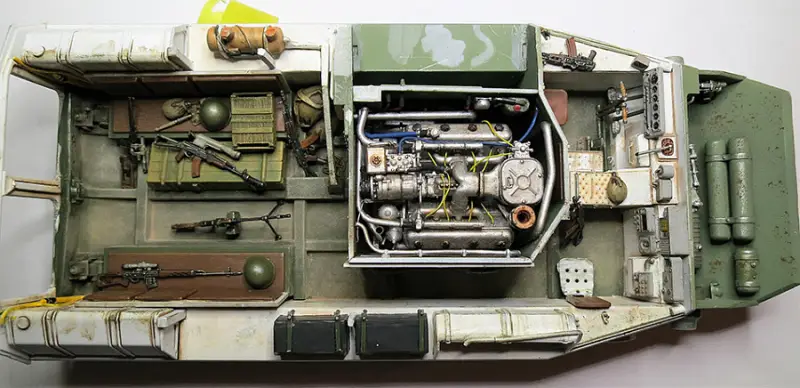
The in-line YaMZ-770 will clearly fit into the now classic MTLG layout with the power unit located in front and on the right in the vehicle body. Thus, with purely symbolic increases in the dimensions of the new conveyor, it is possible to increase the useful volume inside the housing.
Two more points, without departing from the drawing.
What should be the cross-section and length of the positive wire to ensure stable engine starting from a slightly weak battery or in cold weather? And how irrationally the front compartment of the hull with the transmission is arranged, how much emptiness there is, due to the small angles of inclination of the front armor plates.
Now let's look at the difference between the body of the new vehicle and the MT-LB. The reasons for the revision were: simplification of manufacturing technology; increasing the base of the tracked chassis to maintain minimal pressure on the ground while increasing the total mass, slightly increasing the vehicle’s protection from modern threats. The main difference from its predecessor is two front sheets instead of three.
Firstly, the geometry is simplified, there are fewer components during manufacturing and welding. If we count from the vertical, then the slope of the lower front sheet on the MTLG is reduced to 40 degrees, in contrast to its predecessor, on which the angle was 45 degrees. Further, the single upper front sheet of MTLG has a slope of 70 degrees from the vertical, while on MT-LB there is a middle sheet with a slope of 80 degrees, and then continues with the front top sheet with a slope of 54 degrees (clarification: or 36 degrees from the horizontal).
On the old model, the lower and upper frontal plates are made of 14 mm rolled armor, apparently intended to provide protection against 14,5 mm KPVT bullets, while at the same time the almost horizontal middle frontal sheet is only 7 mm thick. At MTLG, both frontal plates are made from 14-mm armor, and if possible and willing, but not to the detriment of the overall weight characteristics of the vehicle, from 15-mm.
Secondly, increasing the angle between the front plates of the MTLG hull to 70 degrees (55) allows for more efficient use of the armor volume and shifting the transmission mechanisms and drive wheels forward, which helps expand the base. Next, again, in order to increase the volume on the MTLG, the tilt angle of the upper side sheets of the hull was reduced to 20 degrees (23).
All side and stern sheets of the MT-LB have a thickness of 7 mm; reliable data on the bottom and roof could not be found. But be that as it may, if when designing a new car there is a reserve of weight, after all the modifications it would not hurt to use it to strengthen the protection of the bottom and roof of the hull.
But let’s not be distracted from the main task of creating a new transporter - to become a platform for placing a 125-mm howitzer with a barrel length of 39 calibers. If it can withstand the loads of artillery fire, then all other options for armament and use are feasible without restrictions.
Under the USSR, they didn’t bother much with this problem and simply added a seventh pair of road wheels to the increased length of the hull - the result was the “Gvozdika”. If for the MT-LB the load on the road wheel was a little more than a ton, then for the Gvozdika it increased by 120 kilograms, which is not critical given the safety margins included in the projects of that country. Assuming the mass of the new MTLG-based self-propelled gun is 17–18 tons, the load on the roller should be assumed to be 1,5 tons. Starting from the existing sample, we increase the diameter of the new roller to 70 cm (67) and the width of the rubber tire to 15 cm (14), of course, the weight will also increase - 50 kg (43,4).
I don’t really want to embark on the slippery path of competition with narrow specialists in high technology, but even if I fail in my reasoning, it will serve as a lesson to others; in the end, you also need to be able to lose.
It would seem that a significant increase in load in the new project also implies replacement of torsion bars.
Here are the data of the original MT-LB torsion bar, designed for a vehicle weight of 12,2 tons, in brackets I will indicate the same parameters for the American Bradley infantry fighting vehicle weighing 22,8 tons: torsion bar diameter 44 mm (48); length 2 mm (110); weight 1 kg (950). Does anything bother you?
If you make primitive calculations of the volumes of two cylinders and then multiply by the density of iron, then the weight of the American part practically coincides with the given figure. But our torsion bar seems to be made of AMG...
Therefore, for our new product we will choose something in between: diameter 46 mm; length 2 mm; weight 100 kg.

And finally, let’s walk through the caterpillar.
An increase in the base of the tracked chassis of the new project to 3 mm (900) and a higher location of the axle of the drive wheels 3 mm (700) will require a slight increase in the length of the tracks. According to table No. 712, the length of the caterpillar on the MT-LB is almost 610 meters with 3 elements.
None of the best examples of tracked vehicles in the world listed in the table, except the MT-LB, can afford such a luxury! If you don’t change anything, then on MTLG the number of tracks will increase by about six more units. With a sufficient length, even a monolithic I-rail can be turned into an arc with little effort. And the ability of a small track on a flat surface to depict a fairly deep bend without much effort is beyond doubt; such a property is fraught with the loss of the track when making turns with the conveyor, especially with severe wear and weakened tension.
For a new, heavier vehicle, it is simply necessary to increase the track pitch, but not radically, 115 mm (111), in order to maintain all the advantages of a small track. This is a rather controversial proposal; on the one hand, everything cannot be taken to the point of absurdity; on the other hand, such an increase in the size of the product will still amount to at least 110 pieces on a new machine. But it is impossible to keep the track from the MT-LB due to the increase in the width of the road wheels.
And if so, then the second proposal for a new caterpillar is more radical: on every second track, abandon a pair of guide teeth, that is, make it flat. The increased diameter of the road wheels and the reduced flexibility of the new caterpillar during lateral bending will not worsen the driving performance of the conveyor as a whole, but the absence of teeth on every second link will provide good weight savings. In the end, since the tracks are interchangeable, they can be combined in other proportions, say, through two toothed ones and one flat one. Everything will be determined by mechanics under specific operating conditions.
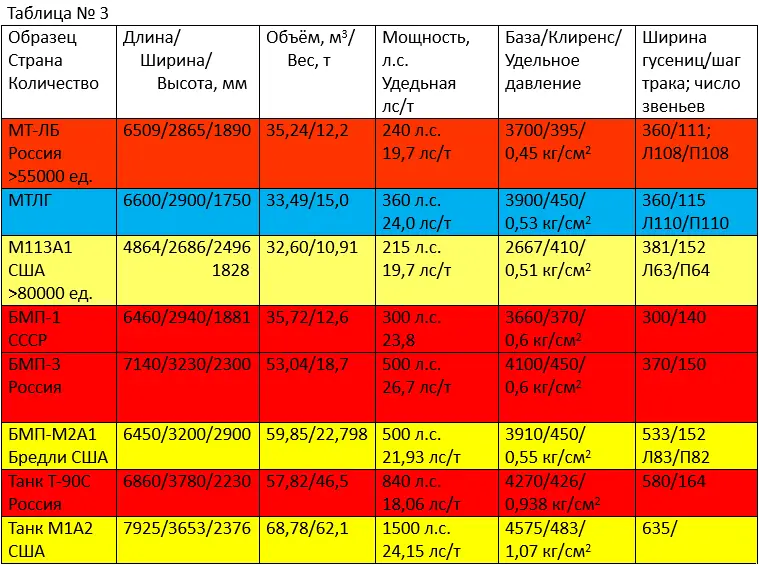
When creating a new vehicle, you must initially abandon the ambitious requirement for its amphibiousness. Modern realities on the battlefield and in the immediate rear leave even the predecessor with the adjective “armored” in the name no chance of survival, let alone overcoming a water barrier with possible fire resistance.
For assault operations there are armored personnel carriers and infantry fighting vehicles with much better armor, weapons and the ability to overcome water obstacles. Let the MTLG become a good tracked transporter, although calculations indicate the ability to maintain positive buoyancy even with a full load of 3 tons. Consequently, the self-propelled artillery installation at its base should not claim to be unparalleled in the world in conquering the water element.
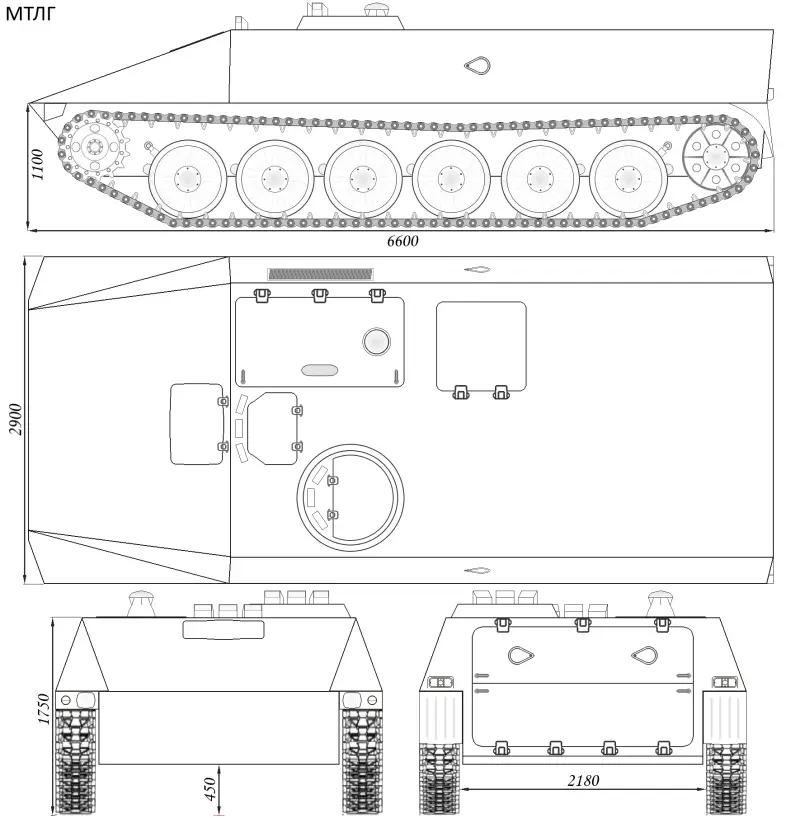
Self-propelled gun "Rosehipnik"
The main armament of the new self-propelled gun should be a 125-mm howitzer-type rifled gun with a barrel length of 39 calibers (4 mm) with a charging chamber volume of within 875 liters. A developed actively reactive muzzle brake should reduce the recoil force from the action of powder gases from a powerful propellant charge by at least fifty percent.
Refusal of the ejector on the barrel will improve its quality and have a positive effect on increasing the firing range; the problem of gas contamination in the fighting compartment can be solved by installing a valve in the breech, through which, before removing the metal frame of the partially combustible cartridge case, the barrel is purged with compressed nitrogen, and only then open the bolt.
Purging with nitrogen will partially prevent oxidation of the metal surfaces of the barrel bore and improve thermal stabilization, since the gas temperature decreases during expansion. The basis of the ammunition load is a heavy (28 kg) high-explosive fragmentation projectile with a five-kilogram explosive charge inside.
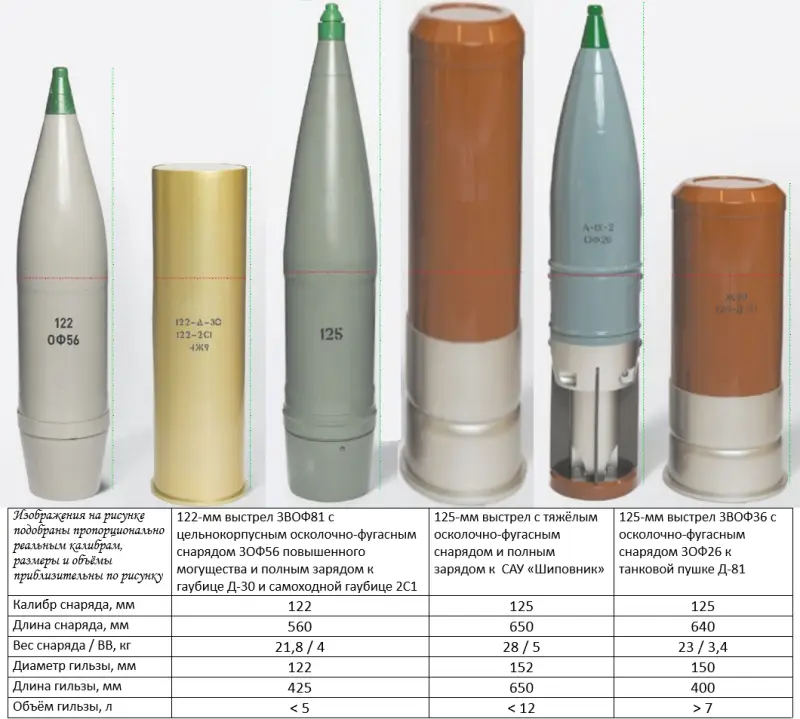
The gun with an automatic loading mechanism is located in the rear part of the MTLG chassis in a fixed turret-superstructure, which provides guidance within 40 degrees horizontally and from –1 to +70 degrees vertically.
The process of aiming the gun, forming a shot and loading are carried out in a fully automatic mode. The onboard automated ammunition control system for seven rounds prepared for firing, modeled after the Swedish self-propelled gun "Archer", ensures loading of the self-propelled gun at any angles of vertical and horizontal guidance without returning the barrel to the loading line, which will allow all seven to be fired at the target at an interval of 10 seconds per minute ammunition.
Thus, with an initial projectile speed of 750 m/sec and firing at a maximum range of up to 20 kilometers, a vehicle with a crew of three can leave the position and go to cover or to reload half a minute before the last ammunition falls on the target.
Two hydraulic jacks are installed in the rear part of the hull to smooth out hull vibrations during firing, reduce the load on the chassis chassis when firing at large vertical guidance angles, improve the leveling of the artillery platform as a whole in preparation for firing and its correction during loading between shots in automatic mode.
In addition, when equipping the Rosehip self-propelled gun with a Doppler locator to determine corrections along the flight path of projectiles, the presence of such devices will increase the stability and accuracy of the radar. It may make sense when creating a new self-propelled gun to switch to electrical equipment for the entire product with a DC voltage of 36 volts.
Electric drives for horizontal and vertical guidance, electrics for the automatic loader, communications and navigation equipment, gun radar, electric drives for hydraulic jacks, BMDU (remote control combat module) of a machine gun installation for air defense tasks, a heating and ventilation system for the crew will require a large amount of electricity.
All these needs can be briefly satisfied by a battery of six batteries of the base chassis with a voltage of 36 volts when the propulsion engine is not running in sound and thermal masking mode during combat work at the front line. But in order to ensure the self-propelled guns are on duty in readiness to open fire, air defense and save the life of the propulsion engine, a backup autonomous power supply unit is also required.
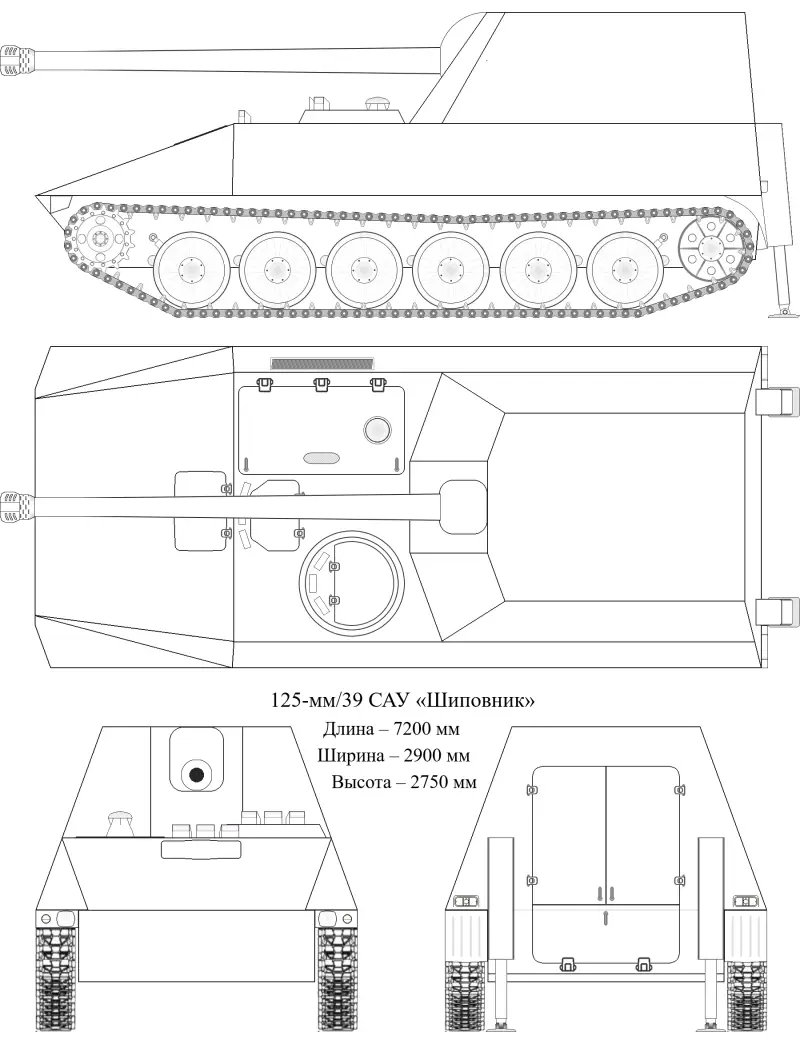
Let's return to the title of the article.
The main premise for the creation of the Malva self-propelled joint stock company is considered to give the large-caliber artillery piece strategic mobility (the ability to transport heavy military aircraft in the shortest possible time over long distances) and high maneuverability in the front-line zone due to the advantages of a wheeled chassis.
So, the proposed version of the Rosehip self-propelled gun will be twice as good as the Malva self-propelled gun according to these criteria. In terms of long-distance transfer, whether in an Il-76 or on a railway platform, the “Rosehip” is placed in a pair; along roads on a 40-ton trailer, the same pair is not much inferior to the opponent. But the arrival at the front of twice as many full-fledged guns more than compensates for their smaller caliber.
In tactical terms, as the Malva combat unit is inferior in specific power and specific ground pressure, deploying an eight-wheeled 13-meter platform off-road or in wooded areas is much more difficult than a tracked self-propelled gun.
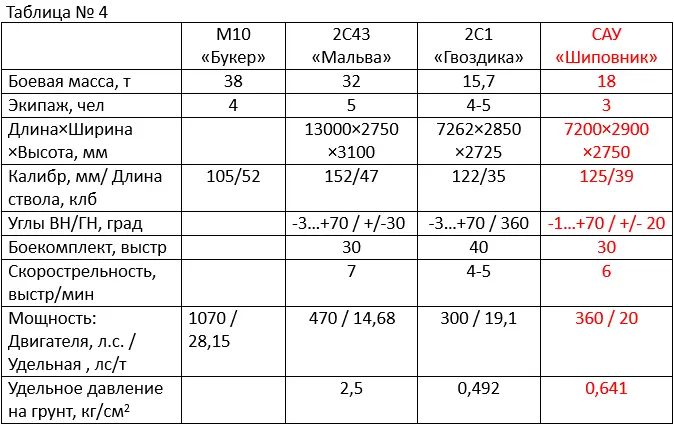
When comparing “Rosehip” with “Booker,” what first comes to mind is a duel situation in the spirit of the battles of World War II, which is unlikely in modern realities.
Firstly, at present, both the enemy’s front line, the strip of territory behind it, and possible routes of approach from the rear are quite clearly visible by reconnaissance means.
Secondly, the troops are quite well equipped with anti-tank weapons (mines, RPGs, portable and self-propelled ATGMs, shock drones and the same artillery on call).
Thirdly, having a sufficient firing range and striking accuracy, it is quite possible for a self-propelled howitzer to occupy a protected, camouflaged position 5–8 kilometers from the front edge. Such a distance will allow its own radar to reliably determine the location of enemy artillery and mortars and effectively counter them.
Otherwise, having good mobility and relatively small dimensions, short raids to the front edge in a certain direction and to pre-selected positions for launching fire raids with subsequent quick rebound are possible. I assume that such work could be more effective if we envisage the use of a pair of self-propelled guns in close cooperation with each other.
Ideally, such a pair of self-propelled guns with their own radars and in close cooperation with a reconnaissance drone will leave no chance on the battlefield not only for the Booker, but also for a more serious enemy, including full-fledged tanks and large-caliber self-propelled guns.
And finally, what can “Rosehip” oppose to a real and strong enemy in the person of the towed American howitzer M777, in the world and behind the scenes - “Three Axes”. The American has a larger caliber, a longer firing range, and there are rumors that the accuracy is better. But it has all the classic disadvantages of a towed gun.
And here are the specifics! The standard crew of the gun is 10 people, including the driver of the tractor, and the minimum crew required for firing is 5 people, with a significant reduction in the rate of fire. As one very popular actor playing the role of a Central Asian said: “America has a lot of people!”
But what about that same rate of fire?
Intensive - four shots per minute for up to two minutes, standard - two shots per minute with control of the barrel heating sensor. Let’s mention the deployment time of “less than three minutes” and the folding time of “less than two minutes” - it seems that the standards for the American army were written by Estonians.
You can argue for a long time about the technical characteristics of guns, add to the dispute the notorious human factor in the form of combat training of crews, motivation and logistics. But, according to the author, since the military conflict has been going on for two years, only economics will fairly judge its results.
According to the 2017 contract for the Indian Armed Forces, the price of one M777 howitzer was $3,7 million, the price of a comparable towed Msta-B howitzer is approaching 30 million rubles, and the D-30A is still fighting at the front (a couple of thousand in storage) , which is estimated at 3 million rubles.
Experts estimate the Malva self-propelled gun at 2,5 million dollars; I probably won’t be much mistaken if I value the Rosehip self-propelled gun in modern realities - less than two million dollars.
Thus, on the battlefield, each individual M777 barrel can be opposed by two Rosehip self-propelled guns.
Victory will be ours, but she loves the prepared.
Information